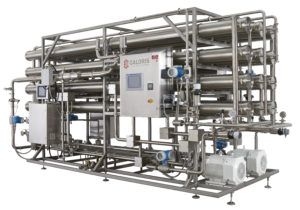RO Condensate Polisher Installation Minimizes Environmental Footprint, Conserves Water (Case Study)
Published on by Water Network Research, Official research team of The Water Network in Case Studies
 A new milk powder production facility was built in a water stressed region with the goal to minimize their environmental footprint as well as conserve water resources.
A new milk powder production facility was built in a water stressed region with the goal to minimize their environmental footprint as well as conserve water resources.
The customer approached Caloris to design and install necessary treatment equipment to recover cow water (vapor condensate) discharging from the evaporation process systems and process it to a quality suitable as Category I, acceptable for use in potable water applications.
Caloris’ technical solution consists of two Reverse Osmosis (RO) Polisher systems capable of processing cow water generated from the evaporation process systems at a permeate rate of 100 gallons per minute for up to 20 continuous hours each day. Because the facility relies entirely on the polished, Category I water to support its operation, they elected to go with completely redundant RO systems. This provides an adequate safety factor and allows for maintenance, etc. on the systems.
Prior to entering the RO systems, the energy from the hot condensate is recovered by pre-heating the whole milk prior to cream separation. After this step, the cool cow condensate enters the RO system. The RO discharge concentrate (at 90% recovery) is safely diverted to the drain, while the RO permeate is disinfected by the inline PMO (Pasteurized Milk Ordinance) UV device and then sent to the potable permeate silos. Automated CIP (inclusive of chemical dosing, heating and cooling) is independently initiated for each RO system at the conclusion of that RO system’s 20 hour production run. Both RO systems are also capable of using well water as a feed source.
The two RO systems were delivered as a single, pre-assembled skid including pre-piped RO element housings, pumps and heat exchangers. This helped reduce the cost of the installation as well as the time to complete the installation.
The project from design, installation to operation took 16 weeks to complete and produces more than 144,000 gallons of potable water for the facility every day.
Media
Taxonomy
- Potable
- Industrial Wastewater Treatment
- RO Systems
- Industrial Water Treatment
- UV Disinfection
- Reverse Osmosis
- Industrial Water Treatment
- Industrial Water Reuse
- Zero Discharge
- Milk
- Evaporation Plants
- Dairy